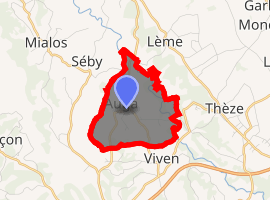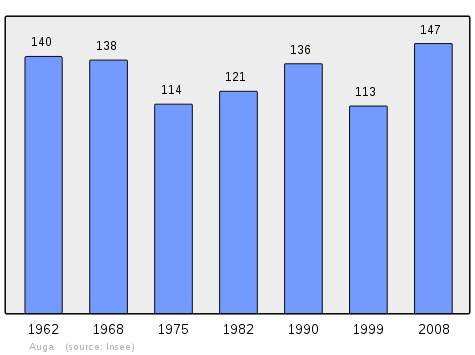Auga
Auga is a commune in the Pyrénées-Atlantiques department in the Nouvelle-Aquitaine region of south-western France.
Auga | |
|---|---|
Countryside in Auga | |
Location of Auga 
| |
 Auga  Auga | |
| Coordinates: 43°28′42″N 0°22′50″W | |
| Country | France |
| Region | Nouvelle-Aquitaine |
| Department | Pyrénées-Atlantiques |
| Arrondissement | Pau |
| Canton | Terres des Luys et Coteaux du Vic-Bilh |
| Intercommunality | CC Luys en Béarn |
| Government | |
| • Mayor (2014-2020) | Jean-Paul Lacabanne |
| Area 1 | 4.03 km2 (1.56 sq mi) |
| Population (2017-01-01)[1] | 153 |
| • Density | 38/km2 (98/sq mi) |
| Time zone | UTC+01:00 (CET) |
| • Summer (DST) | UTC+02:00 (CEST) |
| INSEE/Postal code | 64077 /64450 |
| Elevation | 123–258 m (404–846 ft) (avg. 160 m or 520 ft) |
| 1 French Land Register data, which excludes lakes, ponds, glaciers > 1 km2 (0.386 sq mi or 247 acres) and river estuaries. | |
Geography
Auga is located some 20 km north of Pau and 35 km east of Orthez. Access to the commune is by the D40 road which branches off the D944 just south of Méracq and goes south through the length of the commune and the village before continuing to join the D834 near Sauvagnon in the south. The D220 road goes south from the village to Viven. The commune is mostly farmland with scattered forests.[2]
The Pyrénées-Atlantiques Interurban Network bus line has a stop in the commune on route 842 from Malaussanne to Pau.
The Luy de France flows north up the eastern side of the commune and continues north-west to join the Luy de Béarn to form the Luy north-east of Castel-Sarrazin.[2]
Places and hamlets[3]
Neighbouring communes and villages[2]
Toponymy
The commune name in béarnais is Augar. Michel Grosclaude suggested the etymology is Gascon coming from augar meaning "marshy terrain".[12]
The following table details the origins of the commune name and other names in the commune.
| Name | Spelling | Date | Source | Page | Origin | Description |
|---|---|---|---|---|---|---|
| Auga | Algar | 11th century | Raymond | Saint-Pé | Village | |
| Augar | 13th century | Raymond | Fors de Béarn | |||
| Augaar | 1385 | Raymond | Census | |||
| Augaa | 1437 | Raymond | Homages | |||
| Sent Laurens d'Auguaa | 1538 | Raymond | Reformation | |||
| Augua | 1544 | Raymond | Reformation | |||
| Abescat | Abescat | 1673 | Raymond | Reformation | Fief under the Viscounts of Béarn | |
| Baradat | Baradat | 1863 | Raymond | Place |
Sources:
- Raymond: Topographic Dictionary of the Department of Basses-Pyrenees, 1863, on the page numbers indicated in the table. (in French)[13]
- Grosclaude: Toponymic Dictionary of communes, Béarn, 2006 (in French)[12]
Origins:
History
Auriol Centulle, third son of Centule IV, Viscount of Béarn, and Angèle d'Oloron, was lord of Clarac, Igon, Baudreix, Boeil, and Auga.
Paul Raymond noted on page 17 of the 1863 dictionary that the commune had two Lay Abbeys, vassals of the Viscounts of Béarn: Abadie-Susan and Abadie-Jusan. In 1385, Auga had 22 fires and depended on the bailiwick of Pau. Auga was also a ruffebaronnie, vassal of the Viscounts of Béarn.[13]
The fief of Abescat was also a vassal of the Viscounts of Béarn.
Administration
List of Successive Mayors[18]
| From | To | Name | Party | Position |
|---|---|---|---|---|
| 1983 | 1995 | Alexis Cassoulet | ||
| 1995 | 2001 | Michel Chéret | PS | |
| 2001 | 2008 | Pierre Dubourdieu | ||
| 2001 | 2014 | Pierre Chéret | PS | Regional Councillor |
| 2014 | 2020 | Jean-Paul Lacabanne |
(Not all data is known)
Inter-communality
The commune is part of four inter-communal structures:
- the Community of communes of Luys en Béarn;
- the AEP association of Arzacq;
- the Energy association of Pyrénées-Atlantiques;
- the inter-communal association of Aubin-Auga-Doumy-Bournos;
Demography
In 2010 the commune had 140 inhabitants. The evolution of the number of inhabitants is known from the population censuses conducted in the commune since 1793. From the 21st century, a census of communes with fewer than 10,000 inhabitants is held every five years, unlike larger towns that have a sample survey every year.[Note 1]
| 1793 | 1800 | 1806 | 1821 | 1831 | 1836 | 1841 | 1846 | 1851 |
|---|---|---|---|---|---|---|---|---|
| 244 | 239 | 266 | 302 | 344 | 318 | 302 | 307 | 323 |
| 1856 | 1861 | 1866 | 1872 | 1876 | 1881 | 1886 | 1891 | 1896 |
|---|---|---|---|---|---|---|---|---|
| 327 | 303 | 285 | 270 | 259 | 245 | 224 | 171 | 168 |
| 1901 | 1906 | 1911 | 1921 | 1926 | 1931 | 1936 | 1946 | 1954 |
|---|---|---|---|---|---|---|---|---|
| 192 | 190 | 184 | 137 | 134 | 131 | 142 | 148 | 132 |
| 1962 | 1968 | 1975 | 1982 | 1990 | 1999 | 2006 | 2010 | - |
|---|---|---|---|---|---|---|---|---|
| 140 | 138 | 114 | 121 | 136 | 113 | 140 | 140 | - |

Culture and heritage
Civil heritage
The commune has a number of buildings and structures that are registered as historical monuments:
- The Haou Blacksmith's House (19th century)

- A House at Haou (19th century)

- A Farmhouse at Pellarouy (17th century)

- A Farmhouse at Pargade (1733)

- A Farmhouse at Miraut (1830)

- The Maison Lacabanne Farmhouse at Bret (17th century)

- The Maison Labescat House (19th century)

- A Mill at Grange Haget (1707)

- The Maison Dubourdieu House (19th century)

- A Farmhouse at Claux (1780)

- A Farmhouse at Bidot (1801)

- The Chateau d'Auga Fourcade fortified chateau (11th century)

- Houses and Farms (17th-19th centuries)

Religious heritage
The Parish Church of Saint-Laurent (12th century)![]()
The Church contains several items that are registered as historical objects:
Facilities
Education
Auga has no primary school as it is part of an inter-communal educational regrouping with Aubin, Bournos, and Doumy.
Sports
People from the commune play football at ESBDG (Bournos Doumy Garlède Sports Group)
See also
External links
- Auga on Géoportail, National Geographic Institute (IGN) website (in French)
- Anga on the 1750 Cassini Map
Notes and references
Notes
- At the beginning of the 21st century, the methods of identification have been modified by Law No. 2002-276 of 27 February 2002 Archived 6 March 2016 at the Wayback Machine, the so-called "law of local democracy" and in particular Title V "census operations" allows, after a transitional period running from 2004 to 2008, the annual publication of the legal population of the different French administrative districts. For communes with a population greater than 10,000 inhabitants, a sample survey is conducted annually, the entire territory of these communes is taken into account at the end of the period of five years. The first "legal population" after 1999 under this new law came into force on 1 January 2009 and was based on the census of 2006.
References
- "Populations légales 2017". INSEE. Retrieved 6 January 2020.
- Google Maps
- Géoportail, IGN (in French)
- Ministry of Culture, Mérimée IA00026718 Farmhouse at Bidot (in French)
- Ministry of Culture, Mérimée IA00026724 Maison Lacabanne Farmhouse (in French)
- Ministry of Culture, Mérimée IA00026719 Farmhouse at Claux (in French)
- Ministry of Culture, Mérimée IA00026721 Mill at Grange Haget (in French)
- Ministry of Culture, Mérimée IA00026722 Chateau (in French)
- Ministry of Culture, Mérimée IA00026725 Farmhouse at Miraut (in French)
- Ministry of Culture, Mérimée IA00026726 Farmhouse at Pargade (in French)
- Ministry of Culture, Mérimée IA00026727 Farmhouse at Pellarouy (in French)
- Michel Grosclaude, Toponymic Dictionary of communes, Béarn, Edicions reclams & Édition Cairn - 2006, 416 pages, ISBN 2-35068-005-3 (in French)
- Topographic Dictionary of the Department of Basses-Pyrenees, Paul Raymond, Imprimerie nationale, 1863, Digitised from Lyon Public Library 15 June 2011 (in French)
- Cartulary of the Abbey of Saint-Pé, Pierre de Marca, History of Béarn (in French)
- Manuscript from the 14th century - Departmental Archives of Pyrénées-Atlantiques (in French)
- Manuscript from 1343 in the Departmental Archives of Pyrénées-Atlantiques (in French)
- Manuscript from the 16th to 18th centuries - Departmental Archives of Pyrénées-Atlantiques (in French)
- List of Mayors of France (in French)
- Ministry of Culture, Mérimée IA00026728 House (in French)
- Ministry of Culture, Mérimée IA00026723 Maison Labescat House (in French)
- Ministry of Culture, Mérimée IA00026720 Maison Dubourdieu House (in French)
- Ministry of Culture, Mérimée IA00026717 Chateau d'Auga Fourcade (in French)
- Ministry of Culture, Mérimée IA00026715 Houses and Farms (in French)
- Ministry of Culture, Mérimée IA00026716 Parish Church of Saint-Laurent (in French)
- Ministry of Culture, Palissy IM64001172 Furniture in the Church (in French)
- Ministry of Culture, Palissy IM64001176 Furniture in the Church (Supplementary list) (in French)
- Ministry of Culture, Palissy IM64001175 Painting: Christ on the Cross between the Virgin and Saint Laurent (in French)
- Ministry of Culture, Palissy IM64001174 Altar, Altar seating, Tabernacle, and 2 Statues (in French)
- Ministry of Culture, Palissy IM64001173 Balustrade of the gallery (in French)
| Wikimedia Commons has media related to Auga. |